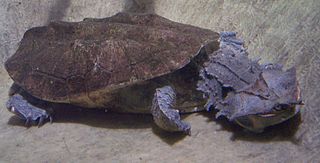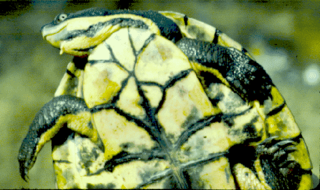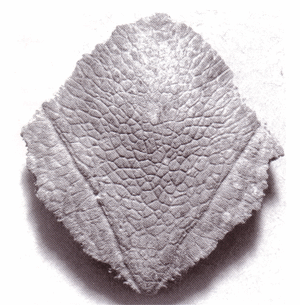
Chelidae is one of three living families of the turtle suborder Pleurodira, and are commonly called Austro-South American side-neck turtles. The family is distributed in Australia, New Guinea, parts of Indonesia, and throughout most of South America. It is a large family of turtles with a significant fossil history dating back to the Cretaceous. The family is entirely Gondwanan in origin, with no members found outside Gondwana, either in the present day or as a fossil.

Chelodina, collectively known as snake-necked turtles, is a large and diverse genus of long-necked chelid turtles with a complicated nomenclatural history. Although in the past, Macrochelodina and Macrodiremys have been considered separate genera and prior to that all the same, they are now considered subgenera of the Chelodina, further Macrochelodina and Macrodiremys are now known to apply to the same species, hence Chelydera is used for the northern snake-necked turtles.
The Namoi River snapping turtle, also commonly known as Bell's turtle, the Namoi River elseya, or Bell's saw-shelled turtle, is a species of turtle in the family Chelidae. The species is endemic to New South Wales, Australia.

Elseya is a genus of large side-necked turtles, commonly known as Australian snapping turtles, in the family Chelidae. Species in the genus Elseya are found in river systems in northern and northeastern Australia and throughout the river systems of New Guinea. They are identified by the presence of alveolar ridges on the triturating surfaces of the mouth and the presence of a complex bridge strut.

Elseya branderhorsti, also known commonly as Branderhorst's turtle and Branderhorst's snapping turtle, is a species of freshwater turtle in the family Chelidae. The species is endemic to southern New Guinea, in West Papua Indonesia and Western Province of Papua New Guinea. Until recently it has been a confusing species due to its lost holotype and its sympatry with another, undescribed, species. E. branderhorsti is currently listed as Vulnerable on the IUCN RedList in part due to its vulnerability to the Asian turtle trade.

The Western New Guinea stream turtle or New Guinea snapping turtle is a species of freshwater turtle in the Chelidae family. It is found in the Bird's Head Peninsula and the Bomberai Peninsula west of Cenderawasih Bay, and on the island of Waigeo of West Papua, Indonesia.

Emydura, the Australian short-necked turtles, are a genus of turtles in the family Chelidae. It was paraphyletic with Elseya. Consequently, it was split into two genera Myuchelys and Elseya by Thomson & Georges, 2009. They can grow quite large, 30 cm or more is not unusual and have a life span of around 20–30 years. They generally do not hibernate as their warmer climate lets them remain active all year round; they also spend more time in the water than other varieties. They are considered omnivore but rely on a constant supply of meat to remain healthy, feeding on basically anything that will fit into their mouth.

The Fitzroy River turtle is a species of freshwater turtle in the family Chelidae. It is the only surviving member of the genus Rheodytes, the other member being the extinct form Rheodytes devisi. The species is endemic to south eastern Queensland, Australia and only found in tributaries of the Fitzroy River.

The Myuchelys is a genus of turtles, the Australian saw-shelled turtles, in the family Chelidae and subfamily Chelodininae. They inhabit the headwaters and tributaries of rivers within their range and this led to the name Myuchelys, which is formed from the Aboriginal word myuna meaning clear water and the Greek chelys meaning turtle. They have a short neck and the intergular scute completely separates the gular scutes. They have no alveolar ridge separating them from the snapping turtles of the genus Elseya.

The saw-shelled turtle is a species of turtle in the Chelidae family endemic to Australia, ranging along rivers and streams and connected swamps and lagoons from coastal Cape York Peninsula to northern New South Wales, with populations also noted as far south as Newcastle -. They are thought to have been introduced to Lake Eacham in the Atherton Tablelands. Other common English names are: serrated snapping turtle or common sawshell turtle.

The Gulf snapping turtle or Lavaracks' turtle is a large species of freshwater turtle in the sidenecked family Chelidae. The species is endemic to northern Australia in northwest Queensland and northeast Northern Territory. The species, similar to other members of the Australian snapping turtles in genus Elseya, only comes ashore to lay eggs and bask. The Gulf snapping turtle is a herbivore and primarily consumes Pandanus and figs.

Elseya dentata, the northern snapping turtle, is a large aquatic turtle found throughout many rivers in northern Western Australia and the Northern Territory. It is one of three species in the nominate subgenus Elseya.
Elseya nadibajagu is a Pliocene species of extinct Australian snapping turtle, described from the Bluff Downs region of Queensland, Australia.

Rheodytes devisi is a Pleistocene fossil turtle from the Darling Downs of Queensland, Australia. It was described from material originally included in the description of Elseya uberima.

Elseya schultzei, commonly known as Schultze's snapping turtle, is a species of chelid turtle endemic to northern New Guinea.

Chelodina insculpta is an extinct species of snake-necked turtle that was described in 1897 from material gathered in Darling Downs, Queensland, Australia, restricted. It is a member of the Chelidae; Pleurodira. The fossil has been dated as Pliocene to Pleistocene.

Elseya rhodini, the southern New Guinea stream turtle, is a recently described aquatic species of chelid turtle found south of the central ranges of New Guinea. It inhabits small streams that flow into the major river drainage's south of the ranges.
Elseya flaviventralis, the yellow bellied snapping turtle, is a species of large river snapping turtles from the Arnhem Land region of the Northern Territory of Australia. It is a member of the nominate subgenus Elseya.

Scott A. Thomson is an Australian herpetologist, paleontologist, and taxonomist, specialising in turtles of the family Chelidae.
Yolarnie Amepou is a zoologist and conservationist from Papua New Guinea. She is known for her work to protect the Papuan softshell turtle in Kikori. In 2017 she was a Youth Champion for the Sustainable Development Goals of the United Nations. She was also received a Pride of Papua New Guinea Award for Environment in 2015.
















